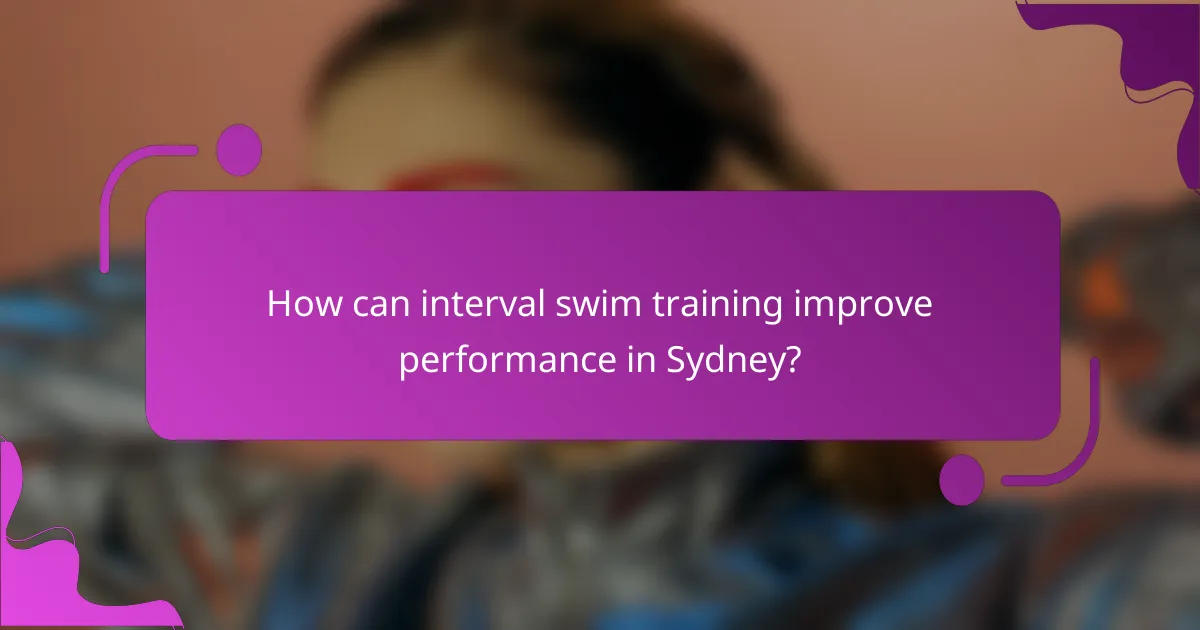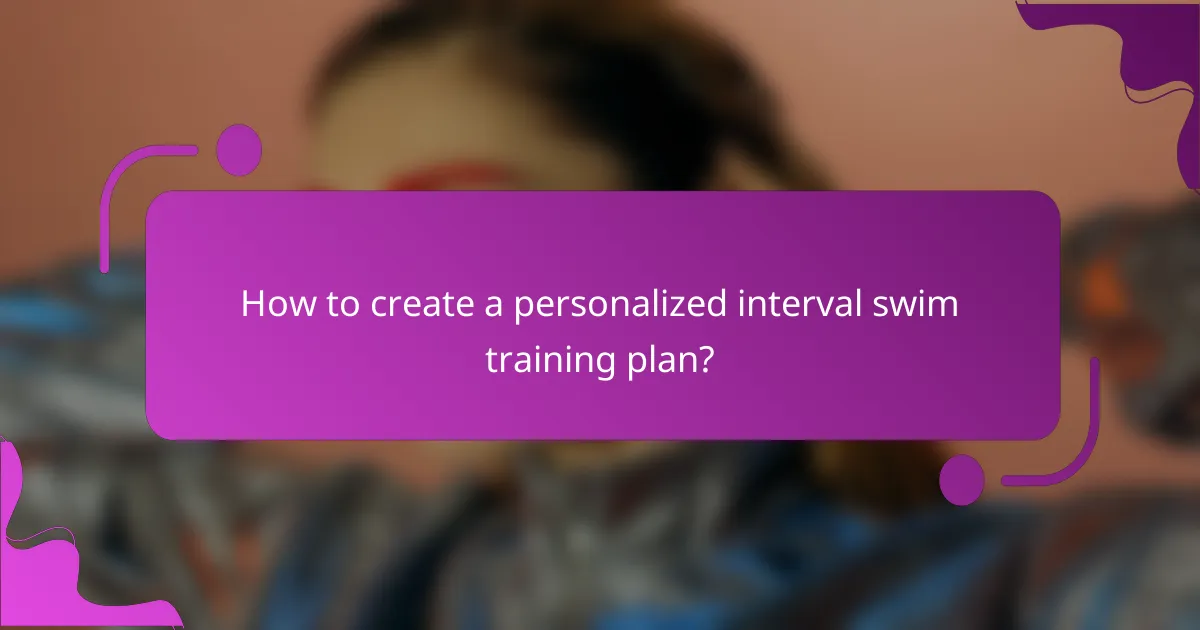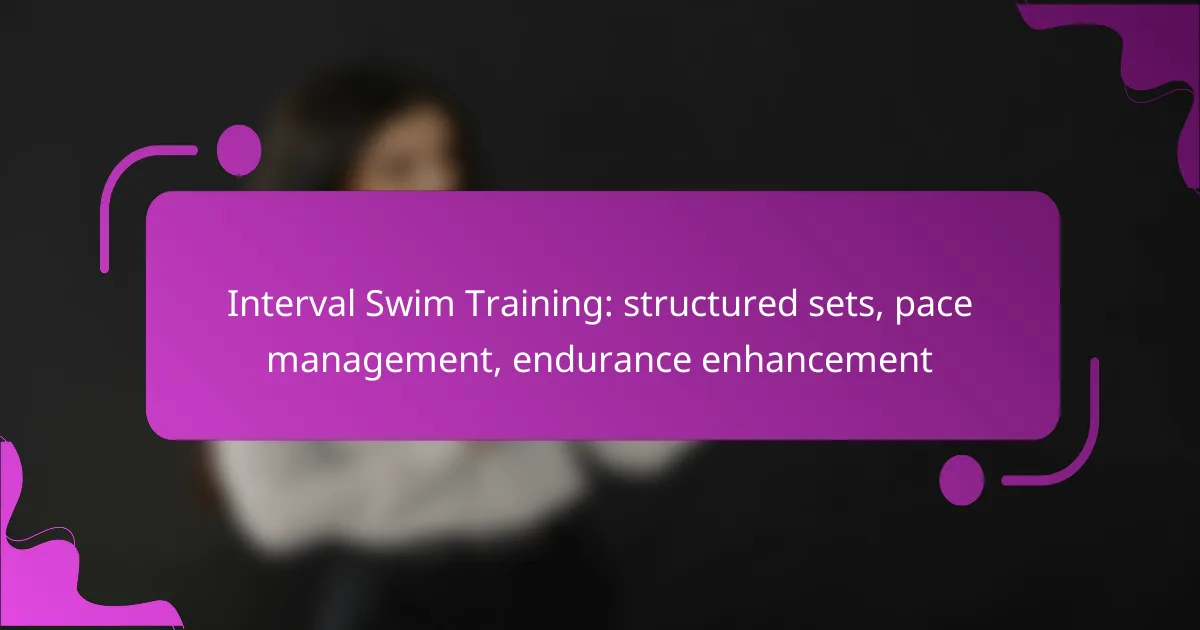Interval swim training is a powerful method for enhancing performance by incorporating structured sets that focus on endurance, speed, and effective pace management. By varying distances and intensities, swimmers can push their limits while strategically managing fatigue, ultimately leading to improved race times and overall fitness. This approach not only builds physical capabilities but also sharpens pacing strategies essential for competitive swimming.

How can interval swim training improve performance in Sydney?
Interval swim training can significantly enhance a swimmer’s performance in Sydney by focusing on structured sets that build endurance, speed, and pacing strategies. This method allows swimmers to push their limits while managing fatigue, leading to improved race times and overall fitness.
Enhanced endurance
Interval swim training boosts endurance by incorporating varied intensity levels during workouts. Swimmers alternate between high-intensity sprints and lower-intensity recovery periods, which helps build aerobic capacity and stamina over time. For instance, a common set might involve swimming 100 meters at a fast pace followed by 30 seconds of rest, repeated several times.
To maximize endurance gains, swimmers should aim for sessions that last between 30 to 60 minutes, focusing on gradually increasing the number of intervals as their fitness improves. Consistency is key; training three to four times a week can yield significant results.
Improved speed
Interval swim training enhances speed by training the body to swim faster over short distances. By incorporating sprint intervals, swimmers develop muscle memory and neuromuscular coordination that translates to quicker race times. For example, performing 50-meter sprints with ample rest can help swimmers learn to maintain speed without succumbing to fatigue.
Swimmers should focus on maintaining proper technique during these high-intensity intervals to prevent injury and ensure efficiency. Aiming for a pace that feels challenging but sustainable is crucial; typically, this might be around 80-90% of their maximum effort.
Better pacing strategies
Interval swim training cultivates better pacing strategies by teaching swimmers how to manage their energy throughout a race. By practicing different paces during training, swimmers learn to recognize their optimal speed for various distances. For instance, a swimmer might practice swimming at a race pace for 200 meters, followed by a slower recovery pace.
To develop effective pacing, swimmers should experiment with different interval lengths and rest periods to find what works best for them. Keeping track of times and perceived exertion during these sets can help refine their pacing strategy for competitive events.

What structured sets are effective for interval swim training?
Effective structured sets for interval swim training focus on varying distances and intensities to enhance speed and endurance. These sets can be categorized into short, medium, and long intervals, each serving distinct training purposes.
Short intervals
Short intervals typically range from 25 to 100 meters and are designed to improve speed and power. Swimmers should aim to complete these sets at a high intensity, often with rest periods that allow for partial recovery. For example, a common set might include 10 x 50 meters at maximum effort with 15-30 seconds of rest in between.
When incorporating short intervals, focus on maintaining good technique under fatigue. Avoid the pitfall of sacrificing form for speed, as this can lead to injury and hinder long-term progress.
Medium intervals
Medium intervals usually range from 100 to 400 meters and help build aerobic capacity while still emphasizing speed. These sets can be performed at a pace that is slightly faster than race pace, with rest intervals that allow for sufficient recovery, typically around 20-60 seconds. An example set might include 6 x 200 meters at a strong effort with 30 seconds of rest.
To maximize the benefits of medium intervals, swimmers should focus on pacing strategies. It’s important to start each interval strong but maintain a consistent effort throughout to avoid burnout before the set is complete.
Long intervals
Long intervals generally range from 400 to 800 meters and are aimed at enhancing endurance and stamina. These sets should be swum at a steady pace, often close to race pace, with longer rest periods of 1-2 minutes to facilitate recovery. A typical workout might include 4 x 400 meters at a controlled pace with 1 minute of rest.
When executing long intervals, it’s crucial to monitor pacing and breathing. Swimmers should aim to maintain a steady rhythm and avoid going out too fast, which can lead to fatigue and impact overall performance. Regularly incorporating long intervals into training can significantly improve endurance over time.

How to manage pace during interval swim training?
Managing pace during interval swim training is crucial for optimizing performance and endurance. By employing effective strategies, swimmers can ensure they maintain an appropriate speed throughout their sets, enhancing overall training effectiveness.
Using a pace clock
A pace clock is an essential tool for swimmers to track their intervals and rest periods. Swimmers should familiarize themselves with the clock’s layout, noting the seconds and minutes to help gauge their pace during sets. Aim to start each interval at the same time, allowing for consistent pacing.
For example, if you are swimming 100-meter repeats, set a target time for each repeat and use the pace clock to monitor your progress. Adjust your effort based on how much time you have left before the next interval begins.
Implementing negative splits
Negative splits involve swimming the second half of an interval faster than the first half. This strategy helps build endurance and teaches swimmers to manage their energy effectively. Start each interval at a controlled pace, then gradually increase your speed as you approach the finish.
For instance, if your goal is to swim 200 meters, aim to complete the first 100 meters at a steady pace and then push harder for the last 100 meters. This approach not only improves speed but also enhances mental toughness during training.
Monitoring heart rate
Monitoring heart rate during interval swim training can provide valuable insights into your effort levels and recovery. Use a waterproof heart rate monitor to track your heart rate throughout your sets. Aim to stay within a specific heart rate zone to optimize training benefits.
A common target is to maintain your heart rate at 70-85% of your maximum during intense intervals. After each interval, allow sufficient time for your heart rate to drop before starting the next set, ensuring effective recovery and performance.

What are the benefits of interval swim training for local swimmers?
Interval swim training offers significant advantages for local swimmers, including improved endurance, better technique, and a lower risk of injury. By incorporating structured sets and pace management, swimmers can enhance their overall performance and swimming efficiency.
Increased aerobic capacity
Interval swim training boosts aerobic capacity by alternating between high-intensity efforts and recovery periods. This method encourages the body to adapt to varying levels of exertion, ultimately improving cardiovascular fitness. Swimmers can start with intervals of 30 seconds to a minute of fast swimming, followed by equal or longer rest periods, gradually increasing intensity as their fitness improves.
For effective training, aim for sessions that include multiple sets of intervals, totaling around 20 to 30 minutes of active swimming. This approach can lead to noticeable improvements in endurance over time.
Enhanced technique
Structured interval sets provide swimmers with opportunities to focus on technique while maintaining a challenging pace. By breaking down strokes into manageable segments, swimmers can concentrate on form, breathing, and efficiency during each interval. This focused practice helps to reinforce good habits and correct any flaws in technique.
Consider incorporating drills into your interval training, such as single-arm swimming or catch-up drills, to further refine your skills. Regularly assessing your technique during these sessions can lead to substantial improvements in overall performance.
Reduced injury risk
Interval swim training can help reduce the risk of injuries by promoting gradual increases in intensity and allowing for adequate recovery. By alternating between high-intensity swims and rest, swimmers can minimize the strain on muscles and joints, which is particularly important for those training in local pools with limited space.
To further mitigate injury risk, ensure that your training plan includes proper warm-up and cool-down routines. Stretching and strength training can also complement your swimming regimen, enhancing overall stability and resilience against common swimming injuries.

What prerequisites are needed for effective interval swim training?
Effective interval swim training requires a solid foundation in basic swimming skills and a clear understanding of pacing. These prerequisites ensure that swimmers can safely and efficiently execute structured sets to enhance their endurance and performance.
Basic swimming skills
Before engaging in interval swim training, swimmers should be comfortable with various strokes and techniques. Proficiency in freestyle, backstroke, breaststroke, and butterfly allows for versatility during workouts and helps prevent injuries.
Swimmers should also master essential skills such as breathing techniques, body position, and turns. Practicing these skills can enhance efficiency in the water, making interval training more effective.
Understanding of pacing
A solid grasp of pacing is crucial for interval swim training, as it helps swimmers manage their energy throughout sets. Swimmers should learn to identify their target pace for different distances, which can vary based on fitness levels and training goals.
Using tools like a stopwatch or swim watch can aid in tracking pace during workouts. Swimmers should aim to maintain a consistent speed that allows them to complete all intervals without excessive fatigue, typically within a range of 70-85% of their maximum effort.

How to create a personalized interval swim training plan?
To create a personalized interval swim training plan, start by evaluating your current abilities and setting clear objectives. This structured approach will help you enhance your swimming performance effectively.
Assess current fitness level
Begin by determining your current swimming fitness level. This includes evaluating your endurance, speed, and technique through time trials or swim tests. For instance, you might swim a set distance, like 400 meters, and record your time to establish a baseline.
Consider factors such as how many laps you can swim continuously and your comfort with different strokes. This assessment will guide the intensity and duration of your interval sets.
Set specific goals
Once you understand your fitness level, set specific, measurable goals. These could range from improving your lap time by a certain percentage to increasing your overall distance swum in a session. For example, aim to reduce your 100-meter time by a few seconds over a set period.
Ensure your goals are realistic and time-bound, allowing for adjustments as you progress. This clarity will keep you motivated and focused during your training sessions.
Incorporate recovery periods
Recovery periods are crucial in interval training, allowing your body to recuperate and prepare for the next effort. Plan for short rest intervals between sets, typically ranging from 15 seconds to a few minutes, depending on the intensity of the workout.
For example, after a fast 50-meter swim, you might rest for 30 seconds before the next interval. This balance between work and rest helps enhance endurance and speed while reducing the risk of injury.
